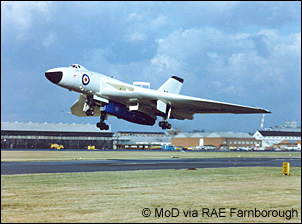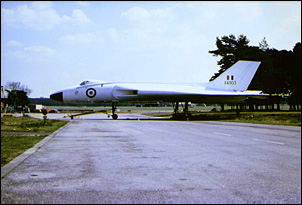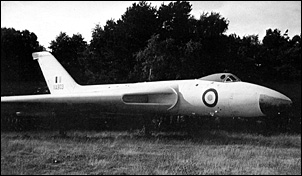Home
History
Blue Steel
Olympus 593
Tornado RB199

Vulcan XA903 Introduction

![]() XA903 flew into Farnborough from Filton on February
27th 1979. The fight crew was from Rolls Royce. This aircraft was the last
of the original version of the Vulcan V-bomber still airworthy, all the
other Mk1s having been scrapped long since. Quite apart from it being
outstanding in this respect, this particular aircraft has other claims to
fame historically. During the 50s, 60s and 70s, it played an outstanding
part in British aviation development.
XA903 flew into Farnborough from Filton on February
27th 1979. The fight crew was from Rolls Royce. This aircraft was the last
of the original version of the Vulcan V-bomber still airworthy, all the
other Mk1s having been scrapped long since. Quite apart from it being
outstanding in this respect, this particular aircraft has other claims to
fame historically. During the 50s, 60s and 70s, it played an outstanding
part in British aviation development.
Completed in June 1957, XA903 was retained by Avro's factory airfield at Woodford instead of being delivered straight away to the RAF squadrons then forming at Waddington, Finningley and Scampton. It was destined for different and important roles even then.
When eventually all this work was completed, the Vulcan was sold to Bristol Siddeley Engines - later taken over by Rolls Royce - and became one of the major tools in the Concorde programme. At the end of its career, no one wanted this lone B1 as museums were preparing for the arrival of Vulcan B2s in a few years time. XA903 was offered to Farnborough for fire training, so ending its career. XA903 was parked on the edge of the disposal compound for some time, being slowly robbed of various items for research. After a while the nose, pressure cabin and forward fuselage were taken away and all that remained was the rest of the airframe sitting down on its rear end with the remainder of the forward fuselage pointing up into the sky.

![]() Bruce Partington was an aircraft apprentice at the
Royal Aircraft Establishment from 1978 to 1982. He recalls his involvement
with XA903:
Bruce Partington was an aircraft apprentice at the
Royal Aircraft Establishment from 1978 to 1982. He recalls his involvement
with XA903:
'In 1979 we were tasked to remove various components from this aircraft as it wasn't going to fly again. It was towed to "E" shed where we were based and we removed all four engines, the air conditioning pack and other bits n' bobs. During this time the aircraft had to be towed about and during one of these moves the lower hatch dropped down and was torn sideways almost out of the aircraft. It hadn't been latched up properly.
'The next morning we removed the door and the remains of the hinges with a cold chisel I'm quite glad that I pinched a bit of the structure we chopped out of the lower hatch frame to remove the hatch, a 3"x2" piece of angle silver one side green the other, with five dome headed rivets and four holes, one mis-drilled too! The aircraft languished about the airfield for several years until, just before an SBAC, show it was dragged out of the dump, "beheaded" and cut up. A very sad end to an illustrious life. The scrappy that cut it up must have made a fortune as the bomb bay was full stainless steel tanks and pipes and the entire rear undersurface of the aircraft was covered with a heat shield made from either stainless or titanium. This was fitted to prevent damage from the afterburner fitted to the RB199.

![]() 'Somebody turned up one day as we were "dropping" an
engine, who had worked on it at Filton. He said that it was the only
Vulcan to have had a gun fired from it, as a Tornado cannon had been
fitted to the RB199 test pod and fired to see if affected the test engine.
I also remember that the RB199 pod was removed at the same time and I saw
it leaving the RAE on the back of a British Aerospace lorry. I suppose it
went back to Filton for the instrumentation and the RB199 to be removed.
It's a pity because that would have made an interesting exhibit in
itself.'
'Somebody turned up one day as we were "dropping" an
engine, who had worked on it at Filton. He said that it was the only
Vulcan to have had a gun fired from it, as a Tornado cannon had been
fitted to the RB199 test pod and fired to see if affected the test engine.
I also remember that the RB199 pod was removed at the same time and I saw
it leaving the RAE on the back of a British Aerospace lorry. I suppose it
went back to Filton for the instrumentation and the RB199 to be removed.
It's a pity because that would have made an interesting exhibit in
itself.'